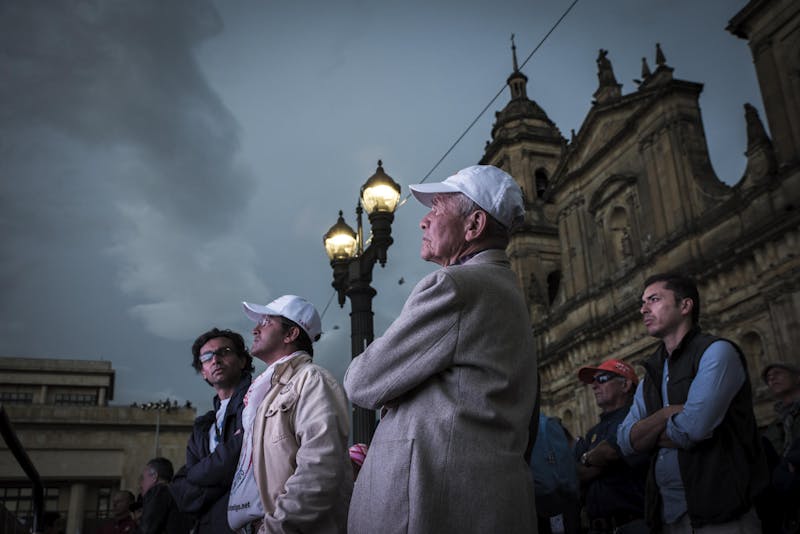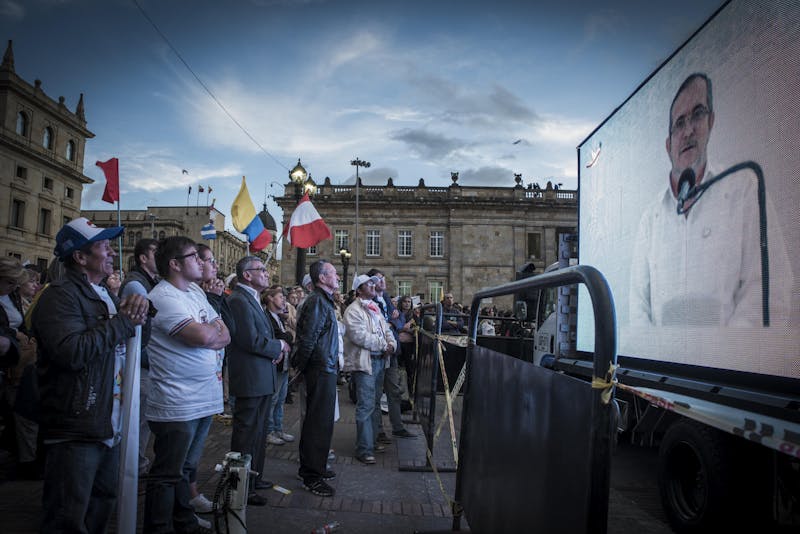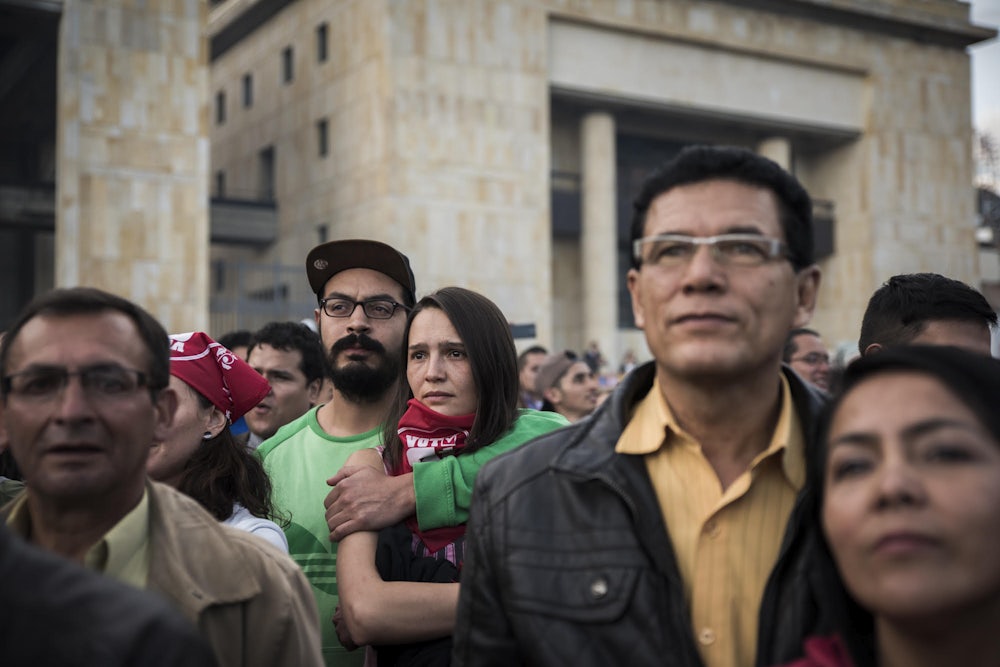The dancer at the head of the second troupe is marching on stilts no less than four feet high, spinning around in an enormous rainbow skirt, the better to show off his frilly lace jacket with matching bonnet and face paint. Every few steps, he flings open his arms and kicks out a metal leg, teetering back as if about to fall, before bringing it down again hard, his hips not skipping a beat.
Mercedes Romero isn’t impressed. “Bogotanos don’t know how to parade,” she says, shaking her graying head. Romero has been living in Bogotá for 12 years now, but she doesn’t much like the Colombian capital (“cold,” “unhappy,” “bad food”) or its cachaco inhabitants (“cold,” “unhappy,” “arrogant”). Sometimes, she misses the Caribbean so much she regrets ever having left. Like millions of other Colombians forced from their homes in the past several decades, and like millions of displaced Afro-Colombians in particular, Romero did have a choice in the matter: the choice to stay or to live. Not everyone made the same choice.
Romero doesn’t say who it was that showed up in her village 12 years ago, but it could have been any of them. The guerrillas, the paramilitaries, the army. She’s from the Montes de María, a cluster of coastal mountains just a short ride south of Cartagena de Indias, the historic port city where Colombian President Juan Manuel Santos and Rodrigo Londoño Echeverri, alias “Timochenko,” the supreme commander of the Revolutionary Armed Forces of Colombia (FARC), are gathered to sign a peace accord bringing four years of negotiation, and 52 years of internecine warfare, to a close.
The Montes de Maria have been one of the areas hardest hit by the Colombian armed conflict. Romero has friends who have started going back, but there are “dark interests” blocking their return. Bad as Bogotá might be, she’s too scared to risk it. “Perhaps with this deal,” Romero says. “We’ll have to see what happens.”
On a sunny morning, after the mist has cleared but before the smog has settled in, you can look out from the base of the mountains that loom over Bogotá’s Plaza de Bolívar and see all the way across the Andean plateau. The city doesn’t stop where your eyeline does, though. It rolls on and on, like the clouds that pour over the Cordillera Oriental behind you, enveloping the hills off to the west and south, vanishing into the interminable northern savannah.
Eight million people live here, the same number of people who have been victimized by the Colombian armed conflict. Eight million rapes and deaths and kidnappings that have been attributed to the various conflict actors. But with some perspective, the picture gets blurry around the edges. There are desechables in Bogotá—homeless, shoeless, and forgotten—who will never be included in any census, bodies buried in the Colombian jungle that will never be found, and that would never be claimed if they were. The conflict has no more respect for the neat borders drawn around it than does the city’s endless sprawl.
Violence in Colombia bleeds through easy classifications. Many perpetrators in the Colombian conflict are themselves victims. The mercurial street gangs that have haunted Bogotá for a generation may not carry ideological pretensions, but they recruit from the improvised shantytowns that have sprouted up as refugees from the war-torn countryside settle along the city’s ever-expanding periphery. (Bogotá alone has received more than 400,000 members of Colombia’s internally displaced population, which, at seven million people, is the largest in the world.) According to La Fundación Ideas para la Paz, a leading conflict research center and advocacy group, the persistent, overarching patterns of crime in Bogotá owe to the enduring link between those common pandilleros and the very militias that forced many of their parents to relocate in the first place.
The 297-page peace agreement signed by President Santos and Timochenko on Monday seeks to bring a close to an insurgency that ostensibly began in 1964, when the Colombian Army firebombed a small, independent farming commune in the northern Andes. But many historians maintain that the FARC’s revolution is better understood as a continuation of the internecine bloodletting unleashed by the Conservative and Liberal Parties a decade earlier. La Violencia (The Violence), as the period became known, was itself a continuation of the successive civil wars that raged throughout the first century of the Colombian nation-state’s existence—which, in turn, were a continuation of the discord sowed during Spanish colonization.
Colombia has been engaged in internal warfare since before it was even a country. That the state has survived as long as it has speaks not to its stability, but to its tolerance for barbarism.
Besides establishing a framework for transitional justice and for the rebels’ demobilization and reintegration into society, the FARC peace agreement addresses political participation rights, rural development, and the cultivation of prohibited crops like coca (which is used to make cocaine), poppy (which is used to make heroin), and marijuana (which, well, you know). Each of these issues has contributed to the perpetuation and escalation of the FARC’s rural insurgency, but none of them caused it. Violence in the Colombian countryside is a function of how power has been organized from the center of its largest city. The actors fade in and out. The nexuses shift. But the dynamic remains constant. Colombia has still yet to discover what horrors Bogotá is capable of accommodating, and that does not bode well for a peace that comes from the capital.
Valeria Parra isn’t allowed to tell you Sí or No. For that, there are plenty of dueling signs, banners, and posters adorning the windows and soot-stained, graffitied walls of downtown Bogotá. Her job is to walk around the Plaza de Bolívar on behalf of the Ministry of Justice, handing out abbreviated copies of the FARC peace accord and subjecting passers-by to apolitical “pedagogy.” It’s been more than 1,000 days since the announcement of formal negotiations, but with less than a week left before Colombians go to the polls to ratify or reject its contents, few know what’s actually in the final peace deal. Furthermore, no one can say with any certainty how or whether it will be implemented.
“We’re just here to make sure people have the resources to make an informed decision,” says Parra.

The latest polling indicates Sí will win big on Sunday. But the vote isn’t as straightforward as the overwhelming international support for peace has made it seem. Colombians have good reason to mistrust both the FARC and the government, and there are parts of this deal in particular that generate understandable misgiving. FARC commanders who confess to crimes against humanity will receive eight-year sentences entailing “effective restrictions of liberties and rights”—but not jail. Military war criminals without formal accusations already levied against them—of which there are many—may not be prosecuted by the transitional justice system at all.
If the No movement were being led by someone else, Sunday’s plebiscite could have provided a platform for thoughtful dialogue, the kind necessary for the construction of a sustainable peace. But Alvaro Uribe does not do thoughtful,and only resigns himself to dialogue when killing isn’t an option. The former president and sitting senator has led an opposition campaign of such unrelenting mendacity and reckless hysteria it would embarrass Donald Trump. Do you want Timochenko to be president? Santos is submitting the country to terrorism. More so than winning a vote, the goal appears to be to “poison the peace process,” as New York University historian Greg Grandin recently observed. In a country whose land distribution system verges on the feudal, it’s the same strategy the rural elite has used to fight off every half-hearted excuse for agrarian reform that Bogotá has attempted to foist on them.
“In many ways,” writes Grandin:
“Uribe and Santos embody platonic ideals of two opposing political factions: Santos represents the traditional urban oligarchy; Uribe, in contrast, bears the standard of the nouveau-riche country bumpkin, a paramilitary class that, during Uribe’s presidency, had not only taken the highest level of political power but insinuated itself into all the country’s major institutions: the courts, the intelligence system, and the Congress.”
Refined, calculating, and technocratic, Santos is the proud scion of a lineage that dates back to one of Colombia’s criolla liberators. His great uncle served as president in the late 1930s. Until recently, his family owned and operated El Tiempo, the largest newspaper in the country. Before winning the presidency, he had never run for public office.
Uribe’s origins are less noble. His dad was widely known as a drug trafficker and a close friend of the Ochoa clan, of Medellín Cartel fame. One of his brothers, the late Jaime Alberto, was a suspected trafficker, too, linked to a major Colombian branch of the Sinaloa Cartel. Another brother, Santiago, was recently arrested and charged with commanding a death squad. For his part, Alvaro ran Colombia’s Civil Aeronautics authority at a time when the Medellín Cartel had a better fleet than the Colombian Air Force. He served as mayor of Medellín at a time when the drug kingpin Pablo Escobar owned the city, and the governor of Antioquia department at a time when the Castaño brothers were consolidating the narco-paramilitary model that would form the basis for Uribe’s counterinsurgency strategy as president.
But it would be wrong to assume that Santos and Uribe’s respective factions oppose one another on principle. As Minister of Defense, Santos presided over some of the most heinous policies of the Uribe presidency, including the “false positives” incentive structure that compensated soldiers for murdering peasants and passing their corpses off as guerrillas killed in battle. Santos made it to the president’s mansion, the Casa de Nariño, with Uribe’s blessing in 2010, and won a second term in 2014 by triangulating Uribe’s extremist peace process opposition into a broad coalition of leftists, indigenous peoples, Afro-Colombians, and other demographics who otherwise loathe him.
Uribe has taken to accusing Santos of conspiring with the FARC to inflict “Castro-Chavista”-style socialism on the country, but Santos in fact shares with Uribe an abiding devotion to trade liberalization, financialization, privatization, and direct foreign investment in large-scale agro-industry and unfettered mineral extraction. Santos has mastered a more cosmopolitan discourse of human rights and inclusion, but meanwhile the brutality that has long facilitated this common economic project in Colombia has become more sophisticated. “Many of the indicators [of violence] for the general population are down,” explains Alberto Yepes, the director of the Colombia-Europe-U.S. Cooperation, an international human rights group. But the targeted killing and intimidation of specific community leaders has gone up—the “specialization and concentration of violence” is how Yepes describes it.
In the first three weeks after the finalization of the peace agreement last month, at least 13 leaders and activists were assassinated across the country. Gold miners who went on strike in September received death threats from a paramilitary group and threats of layoffs from Gran Colombia Gold, a Canadian multinational previously accused of financing death squads (the lawyer representing their union was gunned down the following weekend). While Santos traveled to the United Nations to gin up “post-conflict” financial support, his government moved to advance a law that Iván Cepeda, a senator from the left-wing Polo Democrático party, has denounced as a “declaration of war on the peasant farmer.”
Cepeda, whose father was one of some 3,000 party leftists killed in the state-sanctioned political extermination that unfolded the last time the FARC looked to integrate into the democratic system, has been a key interlocutor with the guerrillas and perhaps the strongest proponent of the peace process in Congress. But the Zidres Law, he tells The New Republic, “goes completely contrary to the spirit of what was agreed” to between the FARC and Santos’s government. Zidres distributes public parcels to landless campesinos, then mandates that they be developed through “associations” with agro-multinationals—the very companies that have been displacing small farmers under the guise of the armed conflict for decades.
“Nothing,” says Cepeda, “can devalue or minimize” the “transcendental” promise of peace with the FARC, which he and others hope will open new political spaces for the democratic left to occupy. But “if we continue with these nefarious neoliberal schemas, it’s impossible to realize the changes that this agreement proposes and that Colombia truly needs.” That’s why Cepeda and his party are promoting a third option in the run-up to Sunday’s vote: Sí for peace, No to the Santos government. “A tremendous struggle lies ahead,” says Cepeda.
An explosion goes off, and for a second, there is that old fear. But this time it’s only firecrackers. On the giant screens set up between the old Capitol building in Bogotá and the new Palace of Justice, President Santos and Timochenko have just signed a leather-bound, filigreed copy of the peace accord in Cartagena. On the steps in front of the Catedral Primada, a man is weeping by himself. To his right, a circle of teenagers light up a joint. From somewhere in the multitude packed around the stage, the drumming starts up again.
“So beautiful,” says Clara Ines Aguacia de Díaz. At 84, Aguacia is one of a handful of people here older than the FARC—old enough to remember seeing Jorge Eliecier Gaitan, the populist icon whose 1948 assassination, a few hundred feet from the plaza, set the most recent cycle of Colombian violence in motion. “I never thought I’d live to see them put down their weapons,” says Aguacia. She has enlisted her daughter to drag her oxygen tank so that she could be here.
Other families taking in the spectacle are younger. Off by the eastern police barrier, a group of children play hacky sack. I ask one mother in a shirt that reads, “You can’t build peace without women,” what she’d like to tell her infant son about this day 20 years from now. She thinks about it for a bit, looking up at the screen and back down at the stroller. “That this was the start of something new.”

What the “new” will consist of can be frightening to even contemplate. Nancy Goméz organizes victims of sexual violence in the vast, oil-rich eastern plains of Meta, a longtime rebel stronghold. “We are doubly victimized,” she reflects. There’s the trauma of violence, of course. “Then the men all go off to war and leave us to lead the resistance, to recover our territories.” With the FARC forming a political party, Goméz doesn’t know if all her group’s efforts will be supplanted by the returning men. She’s worried, too, because some of the paramilitaries she and other members testified against are set to be released from their own transitional justice process this year, and there’s no longer an armed group in the region to maintain order.
People are nervous everywhere, says Lorena Carrillo, who has been touring the country with the Center of Investigation and Social Education (CINEP), one of Colombia’s oldest and foremost human rights groups. “They know how to live in the middle of war but not in peace.”
Marcela Velandia, of the invaluable Center for Historical Memory, believes the past can serve as a guide in that respect. “We, as a people, need to learn to look back, without anger, without hate, without resentment. That’s the only way we can progress, truth and forgiveness. Peace isn’t something that happens from one day to the next, but we can’t keep going like this, blinded by our pain.” On the south side of the plaza, near a black-and-white photo display of disappeared persons laid out by another foundation, Valendia has strung up big sheets of paper and plastic, inviting any and all to come “paint peace.”
“Once we know the truth,” she says, “then we’ll have to decide what kind of country we want.”
One by one, their names get called on the loudspeakers. Mauricio Macri, president of Argentina. Boos. Nicolás Maduro, president of Venezuela. Equal parts boos and cheers. Enrique Peña Nieto, president of Mexico. A stadium full of merciless Bogotan whistles. And so on. Humberto de la Calle, the government’s chief negotiator, gets the biggest applause. The only one close is Timochenko.
Timochenko came up through the ranks as a battle commander, not a political strategist. But his speech tonight strikes a gracious, conciliatory note. It’s strong on themes of poverty and exclusion but light on the language of class war. At one point, we can see on the screen a military jet flying over the stage in Cartagena, and there’s something almost endearing to the way he jolts out of instinct. In the Plaza de Bolívar, a well-dressed businessman in suede leather shoes and stylish glasses laughs at a hardened killer who, not too long ago, would gladly have held him for ransom. For the first time this afternoon, the Plaza de Bolívar is silent.
“We are going to comply,” Timochenko promises, “and we hope that the government complies.” When it comes to maintaining the accord, that may be the only line that matters.
The climax of Santos’s speech is a riff on the dawn that follows the “horrible night,” on the coming of the day “with all its promises.” But in the Plaza de Bolívar, it feels like the other way around. The most wanted terrorist in the country traded weapons for words, and people who share none of his ideas stood and listened to them anyway. Tomorrow will bring a new day, and a whole new host of reasons why peace won’t work. But for now, there is at least some hope that it might.
